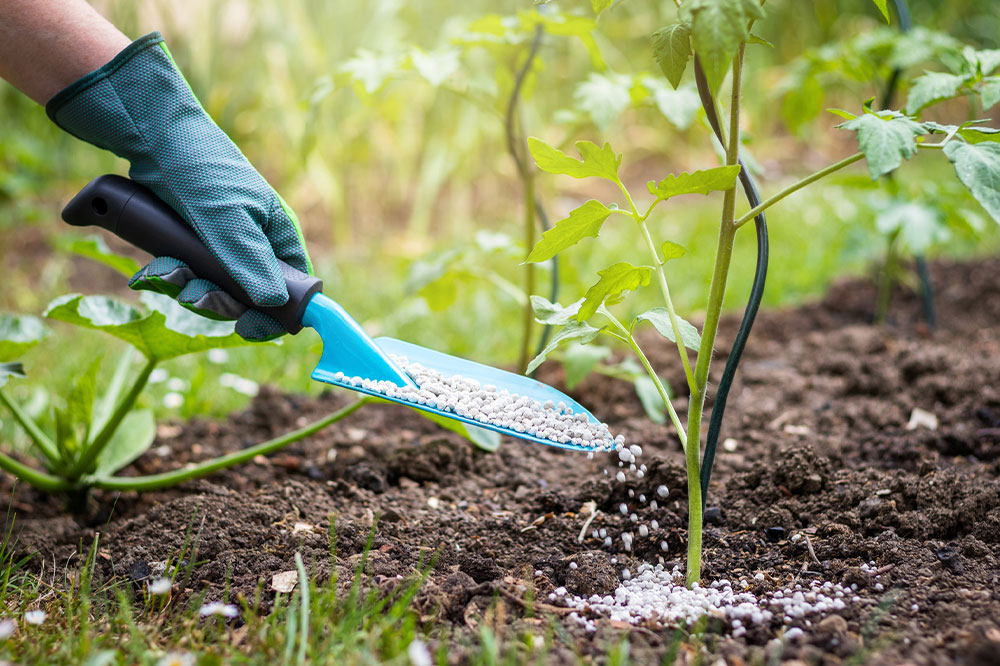Tomato Fertilizers – Uses, Benefits, and Costs
Tomato plants in full bloom can add color to one’s garden. That said, tomato plants need a lot of care, patience, and nurturing to grow and thrive. Since tomato plants have longer cultivation cycles than most other fruit and vegetable-bearing plants, they need proper nutrition at every stage. So, besides watering them regularly, selecting and using the right fertilizers is essential to aiding their growth and protecting against pest attacks.

Benefits of homemade tomato fertilizers
One of the great things about making homemade tomato fertilizer is its flexibility. Since you are growing your crop at home, it is advised that you also get the soil tested in a lab. This will provide you with a detailed understanding of how the soil is and what nutrients it lacks, and accordingly, you can make your fertilizers to address these concerns.
Nutrients needed by tomato plants
Tomatoes need different nutrients at different plant stages. The main nutrients needed by plants include nitrogen, potassium, and phosphorus. And each of these nutrients adds value at different plant growth stages.
- Nitrogen: This is needed during the transplantation process or stage. Tomato plants need a lot of nitrogen to grow into healthy crops.
- Phosphorus: This is another nutrient needed during the transplantation stage.
- Potassium: This is especially needed during the fruiting cycle of the plant. This helps keep the plant strong and healthy and capable of bearing more and more fruits.
Stages of tomato plant growth and what fertilizer to use
As mentioned, fertilizers are needed at different plant life growth stages. So here’s a guide you can keep handy:
- Pre-planting stage: During this stage, you must adequately prepare the soil so the tomato plant can thrive in its environment. A well-aged compost can be mixed into the soil to add much-needed nutrients. You can also find well-rotted animal manure to mix into the soil. This manure helps slowly release nutrients into the soil.
Compost can easily be prepared at home using all the vegetable and fruit waste collected from the kitchen and mixed with soil. It usually takes close to three months to turn this kitchen waste into soil compost that can be used. You can watch some tutorials or speak to any local expert in composting. - Seedling stage: At this stage, you have to be extremely careful with the fertilizer. Over-fertilizing the soil may compromise the young seedling’s health, so take it slow. If your plant needs any help, you can dilute any available organic fertilizers on the market, like fish emulsion or seaweed extract. Dilute these liquid fertilizers with water and then spray them on the soil.
- Early growth stage: This is when the plant needs a nitrogen boost. This helps in promoting the leafy growth of the plants. You can use any of the eco-friendly fertilizers available on the market. Or even use the liquid fish emulsion, which will be very helpful.
- Flowering and fruit development stage: In this stage, you must add a lot of phosphorus and potassium for healthy and strong growth. Ensure not to overdo the nitrogen at this stage because it will only lead to more leaves. You need more fruits than leaves at this stage. Use banana peels in the soil to help with this growth stage. These need to be incorporated into the soil around each plant.
- Maintenance: This is the last stage of the growth cycle when the fruits have already been borne. Use compost regularly around the plant and maintain a layer of mulch to conserve moisture. This will help in the gradual release of nutrients into the soil.
Popular and eco-friendly tomato fertilizer brands and costs
Some brands to check out are mentioned below:
Espoma Tomato Tone Organic Fertilizer (3-4-6): Apart from being environmentally friendly, this fertilizer also improves the tomatoes’ taste. It encourages strong root development, so the plant remains healthy throughout the growth cycle, and due to the slow-release formula used in the fertilizer, it is ensured that the plant remains nutrient-rich throughout. The fertilizer costs about $25.
Burpee Organic Tomato and Vegetable Granular Plant Food (3-6-4): This fertilizer can be used on your tomato crop and the rest of your crops. So if you have any other vegetables or fruits growing in the patch nearby, you can apply this. The fertilizer especially helps in increasing the yield of the crop. It costs about $10.
Miracle-Gro Performance Organics Edibles Plant Nutrition Granules (3-3-3): This works on tomatoes, other vegetables and fruits, and also herbs. It works well if you have a kitchen garden with many growing crop varieties. It also helps enhance the tomatoes’ taste and multiply the yield. It costs approximately $12.
Neptune’s Harvest Tomato and Veg formula Fertilizer (2-4-2): This one uses a fish and seaweed blend and is designed with a formula to help with your tomato’s growth and yield. This liquid fertilizer can be mixed with water to dilute it and can be used to sprinkle directly or even put in the irrigation system that helps water the plants. It costs approximately $30.
Jobe’s Organics Vegetable and Tomato Fertilizer Spikes(2-7-4): These spikes can be inserted into the soil near the tomato plant, and they will then continue to release nutrients slowly into the soil nearby as they break down. These are designed specifically for tomatoes and vegetables, so use them carefully. It costs about $9.
Using natural and homemade fertilizers helps keep the crop healthy and ensures no chemicals are used in your food. However, these popular eco-friendly and organic brands are making life easier for those who cannot make their own compost or use other homemade fertilizers. This is a convenient and effective option for them and gives great results.